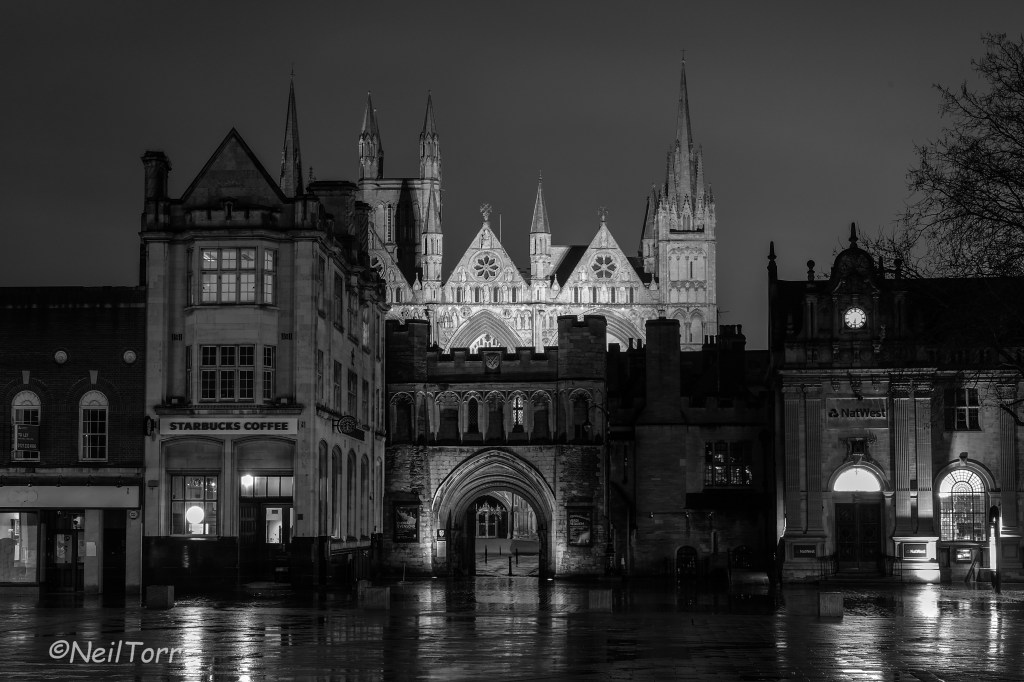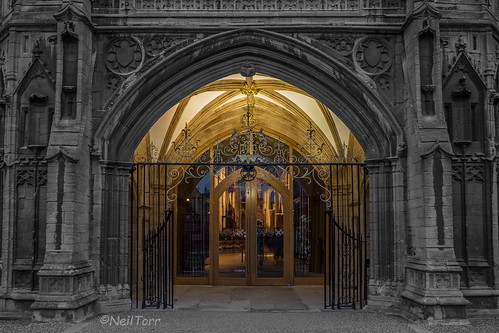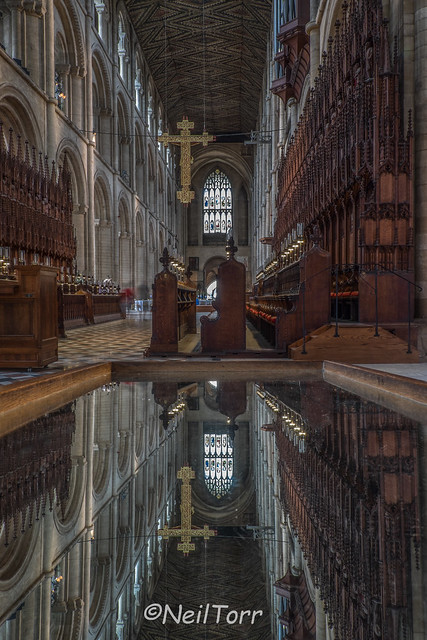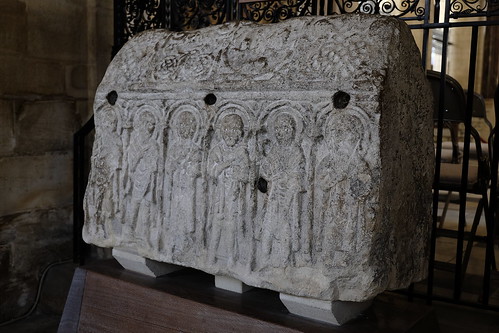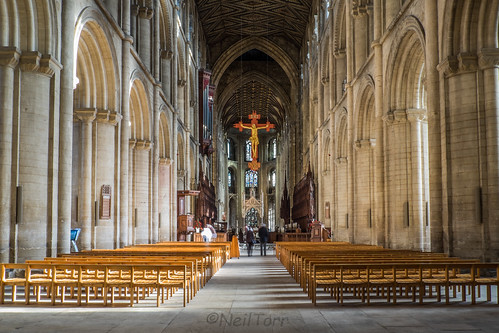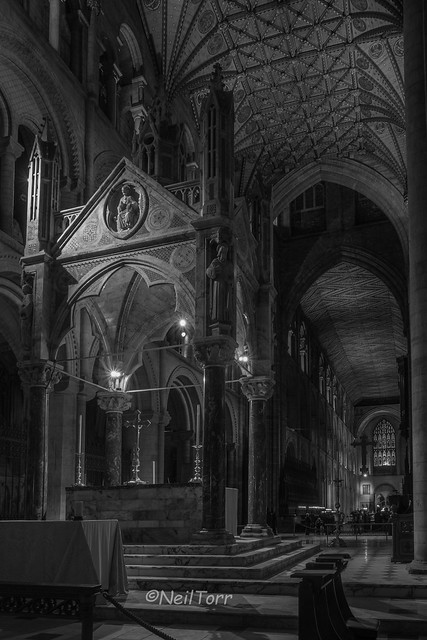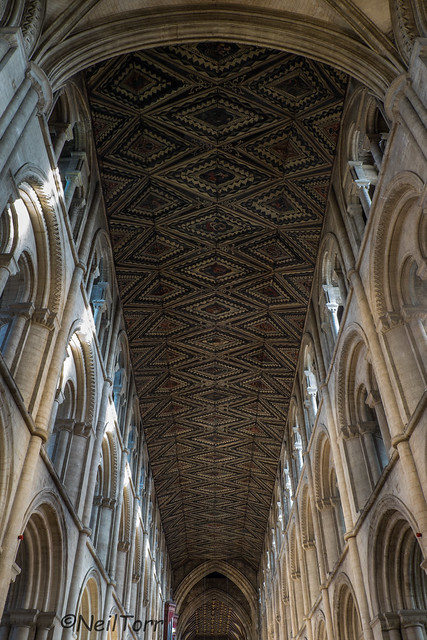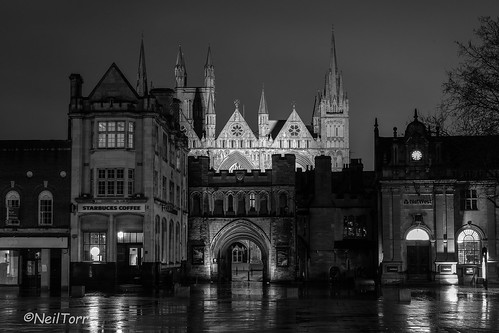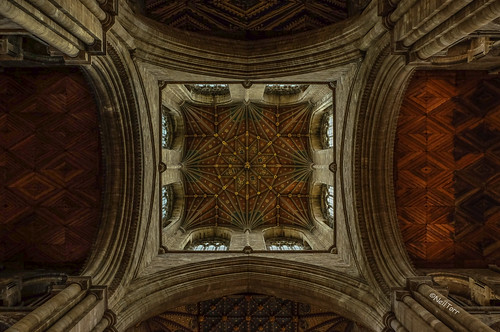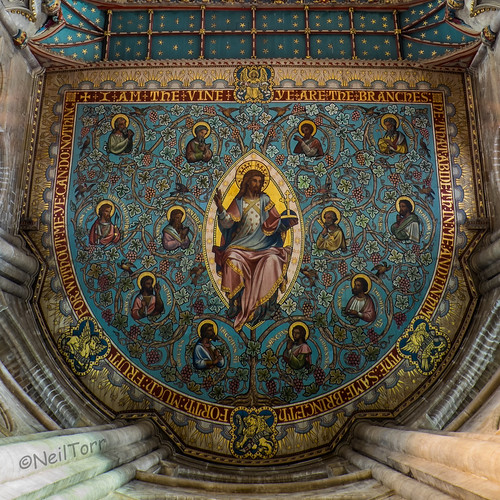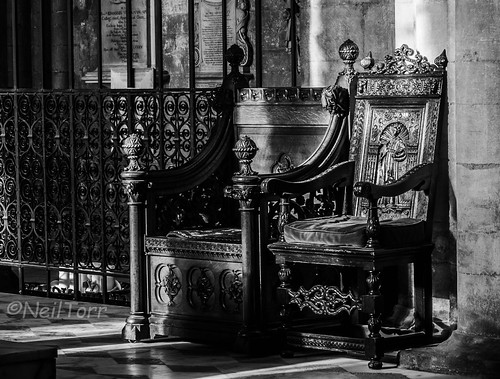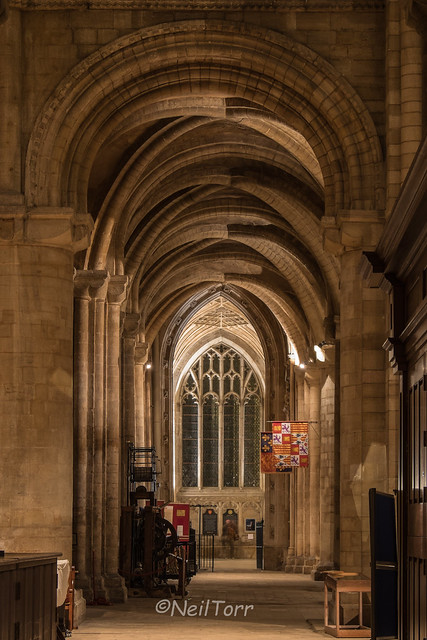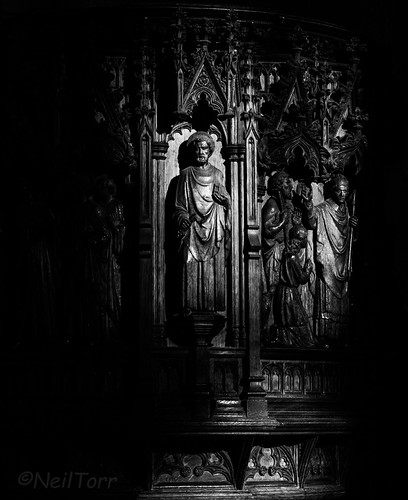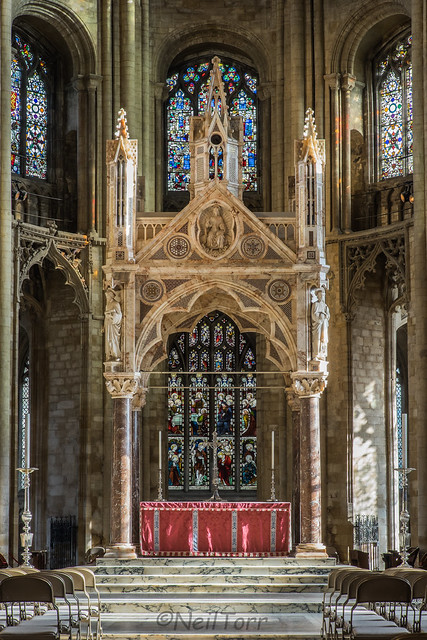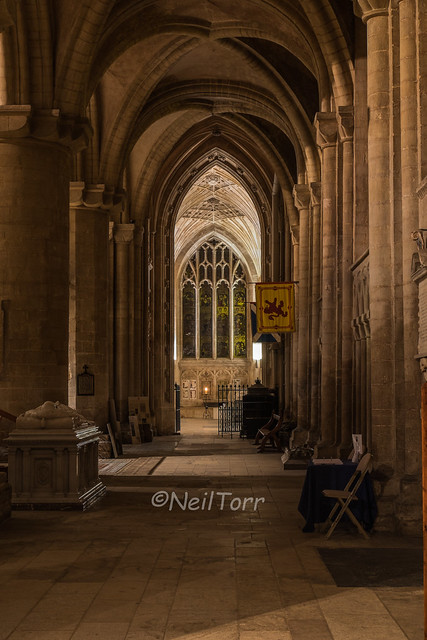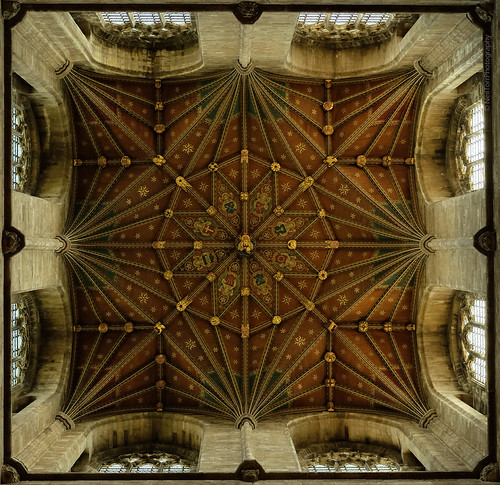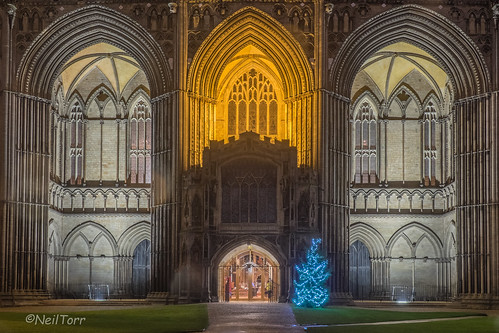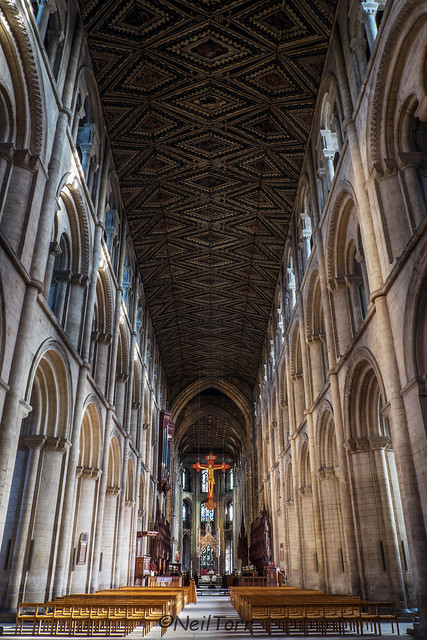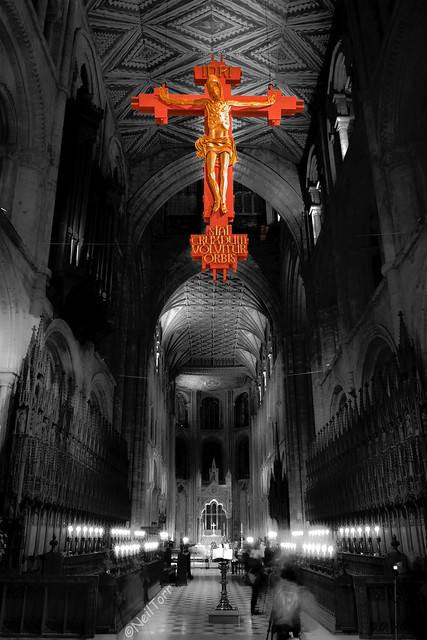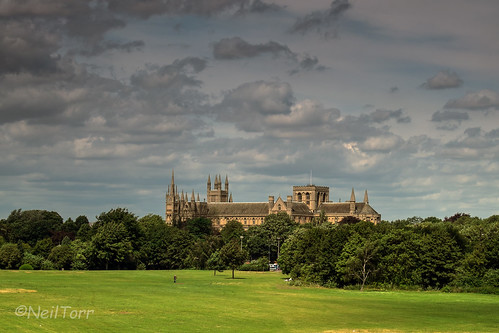Those of you who have read much of my blog will know that one of my favourite subjects to photograph is Peterborough Cathedral. Right in the centre of Peterborough, it is something of a hidden gem. I thought it was time to show some more photos of the Cathedral and that now might be a good time to give a (brief) history timeline to the Cathedral and the part it played in Peterborough’s beginnings. The information that follows is largely from the Cathedral website (http://www.peterborough-cathedral.org.uk/), with some additional items from the visitor centre on the Cathedral grounds.
The photos in the blog won’t necessarily relate directly to the text around them, but those that do should be obvious. Should you have any questions about them please do not hesitate to ask and I shall do my best to answer any questions.
The site of Peterborough Cathedral (more properly Cathedral Church of St Peter, St Paul and St Andrew, but also known as St Peter’s Cathedral) first became a religious site in 655AD when a monastery called Medeswell (later Medehamstede which translates to “the home in the water meadows”) was founded by Saxulf with the aid of Peada, King of the Middle Angles and son of Penda the King of Mercia. During this time Mercia was a pagan Saxon kingdom. The founding of a religious house by Christian missionaries was allowed as part of a marriage contract with neighbouring Christian kingdom of Northumbria.
This original monastery was attacked and destroyed in 870AD, likely by Viking invaders possibly led by Ivar the Boneless, though there is some doubt as to exactly who was responsible. There is a relic of this monastery visible in the Cathedral today, the Hedda Stone, and can be found in the New Building.
In approximately 970AD a new monastery is founded by King Edgar and Bishop Aethelwold of Winchester as a Benedictine house, part of a programme to evangelise the Danelaw. During this time a township starts to appear on the east side of the precincts. The precincts are enclosed by a ditched and embanked wall.
Between the years 1006 and 1055 Abbot Aelfsy collects holy relics including those of saints Kyneburga, Kyneswitha and Tibba. Also during this time in an effort to gain favour from with his abbot a monk from Peterborough Abbey stole the arm of St Oswald (a convert to Christianity and King of Northumbria from 634-642AD) from Bamburgh Castle and took it to him. This was the primary relic of Peterborough until it disappeared from the chapel during the reformation along with its silver casket. The chapel of St Oswald in the South Transept still has a watch-tower where the monks had safeguarded it day and night.
In 1070 the monastery and town is raided by Hereward the Wake and an army of Danish mercenaries to stop the wealth of Peterborough from falling into the hands of the new Norman Abbot. By now the town has become known as Burgh St Peter – Peterborough.
During Hereward the Wake’s resistance to the Norman takeover many of the abbey’s ancillary buildings were destroyed, but the abbey survived.
After Hereward the Wake was forced to retreat in 1071 William I imposed the living of 60 knights on the abbey and its estates and construction of a motte and bailey castle is begun. The motte still remains as Tout Hill in the deanery gardens.
In 1116 a fire breaks out, apparently from an unattended fire in a bakery. This destroyed much of the monastery and town including the abbey which had survived the destruction of the rest of the town in 1070. The Anglo-Saxon Chronicle (the key source for much of the medieval English history was written at Peterborough Abbey in this period) says “all the minster of Peterborough burned, and all the buildings except the chapter-house and the dormitory; and besides, the most part of the town also all burned. All this happened on a Friday; that was 4 August…”
Work begins on the third abbey in 1118. This was to be the start of the present cathedral building. The structure of this original part of the building remains largely as it was on completion.
In 1143 King Stephen visits the monastery and grants a market charter. Then, around 1150, Abbot Martin de Bec creates a new market area to the west of the precincts to bank roll the building of the new abbey. New streets are created around the outside and this street plan largely still exists as the city centre today.
In 1154 the Anglo Saxon Chronicle ends. It is the last chronicle to be written in English for 300 years.
In 1177 relics of St Thomas Becket are brought to Peterborough from Canterbury by Abbott Benedict bringing many pilgrims to the abbey. Around this time building of the Becket Chapel and adjacent hospital begins to house many of the holy relics including those of Becket.
In 1238 the new abbey is consecrated and the structure remains essentially as it was on completion. This includes the original wooden ceiling of the nave – the only one of its kind in this country and one of only four in Europe. The ceiling was completed some time between 1230 and 1250. It has been painted over twice since then but retains its original style and pattern.
In 1307 the monks commission a bridge to cross the river Nene, this was the first Town Bridge. This suffered from bad workmanship and had to be replaced the following year. This second bridge lasted until the 19th Century. A bridge still in the same site today.
In 1308 the main monastic gateway and King’s Lodging (the Norman Arch) is fortified.
Over the following years there are a number of royal visits and stays. Then in 1349 the Black Death arrives in Peterborough, killing one third of the townspeople and half of the monks at the monastery.
In 1370 alterations were made to the central tower of the monastic church. The main beams and roof bosses still present today date back to this time.
Further work in 1375 saw the addition of the Galilee Porch on the west front.
In 1381 during the peasants revolt local rebels assaulted the monastery. This was put down by intervention from the troops of the Bishop of Norwich.
In 1392 and 1394 the two daughters of King Henry IV are born at the monastery, the youngest of which, Philippa, eventually becomes Queen of Denmark.
In 1402 the abbots of Peterborough become ‘Mitred Abbots’, granting them the powers of a Bishop.
In 1461 the town and monastery are sacked by a Lancastrian army during the War of the Roses.
Between 1496 and 1509 the Presbytery roof and in addition the ‘New Building’ is created, an excellent example of late Perpendicular work with fan vaulting probably designed by John Wastell. Wastell went on to work on King’s College Chapel in Cambridge.
In approximately 1510 Abbott Kirkton confiscates land on Boongate to create a private deer park. The entrance to this is now the deanery gateway.
In 1536 Katherine of Aragon – the first wife of Henry VIII – is buried in the monastic church.
In 1539 the abbey of Peterborough is closed and the lands and properties are seized by Henry VIII.
To increase his control over the church in this area Henry VIII created a new bishop (the former abbot John Chambers) and Peterborough Abbey church became a Cathedral by letters patent. The foundation charter of the Cathedral, formally established on 4 September 1541, constituted a chapter of a dean (appointed by the crown) and six canons. At first all six prebends (identified solely by number) were also in the crown’s gift, but Queen Mary transferred this patronage to the bishop during her short reign, and thus it remained to the end of the period covered by the Database. In addition the charter established six minor canons, a deacon, sub-deacon, eight singing men, and eight choristers, two schoolmasters serving 20 scholars and six almsmen. In 1541 the prebends were each valued at £20 (£7 unless resident) and the deanery at £100; taking account of fines and renewals in the 1720s canons could expect an annual income of between £49 and £281.
Henry also founded a grammar school in the precincts of the Cathedral – The King’s School. This was one of 7 King’s Schools founded/given a royal charter by Henry VIII at this time (the others are Ely, Canterbury, Gloucester, Chester, Worcester, and Rochester).
Mary Queen of Scots is buried in the Cathedral in 1587, 5 months after her execution at nearby Fotheringhay Castle. Both execution and funeral were officiated by the Dean, Richard Fletcher. Her body was exhumed by order of her son James I, who moved her remains to Westminster Abbey.
In 1594 Robert (or ‘Old’) Scarlett, the parish Sexton, dies at the age of 98. Old Scarlett was a celebrated local character who, having lived to such an old age, buried two generations from every household in Peterborough. He also claimed to have buried three queens. Katharine of Aragon, Mary Queen of Scots, and his wife Margaret. Though he described his wife as a queen he re-married a year after she died at the age of 89. He is buried just inside the Cathedral and commemorated with a painting and rhyme above the west doors. As you look now there are in fact 2 portraits of Old Scarlett, one a newer framed painting and one wall painting. The wall painting had been covered and forgotten until the newer painting was taken down to be cleaned.
Peterborough was a town with Royalist sympathies and as a result in 1643 the Cathedral was ravaged by Parliamentarian soldiers when the town was taken by Crowell. Nearly all the stained glass was destroyed and the altar and reredos, cloisters and Lady Chapel were demolished. Much of the Cathedral’s library was destroyed by Cromwell’s troops by being burnt in the cloisters. The following description appeared in the Royalist newsbook ‘Mercurius Aulicus’: ‘It was advertised this day from Peterburgh, that Colonell Cromwell had bestowed a visit on that little City, and put them to the charge of his entertainment, plundering a great part thereof to discharge the reckoning, and further that in pursuance of the thorow Reformation, he did most miserably deface the Cathedrall Church, breake downe the Organs, and destroy the glasse windowes, committing many other outrages on the house of God which were not acted by the Gothes in the sack of Rome, and are most commonly forborn by the Turks when they possesse themselves by force of a Christian city.’
In 1648 the Church of England is abolished by Oliver Cromwell. With no bishop the Cathedral becomes a parish church until the restoration of the monarchy and the Church of England with Charles II in 1660.
During this time Charles the I was briefly imprisoned for 2 nights whilst on route to Holdenby House in Northamptonshire, and the masonry of the ruined monastic buildings is sold to pay for repairs. Much of the stonework was used to build Thorpe Hall, the new property for local magnate and Lord Chief Justice Oliver St John.
The last visitation of the plague to Peterborough happened in 1666. The Cathedral clergy flee the city leaving the parish priest of St John’s to bury approximately one third of his parishioners.
In around 1690 Laurel Court is built (and was subsequently extended in the 1720s). Initially it was the Precentor’s house, and is then used for much of the 1700s as the Deanery. Cavell was later to become a war-hero smuggling from behind enemy lines early in World War I before being executed in Brussels in 1915.
In 1728 Earl Fitzwilliam builds the Western Range in the Precincts to house the headmaster, staff and boarders of the King’s School.
Between 1822 and 1830 much of the damage done during the Civil War is repaired under the leadership of James Henry Monk as Dean, though much of his work would be undone during the restoration begun in 1880.
An order-in-council of 1837 reduced the number of prebends in the Cathedral to four, one of which from 1838 was annexed to the Archdeaconry of Northampton.
In 1870 a girls school is established in Laurel Court by Miss Margaret Gibson, remaining open until 1928. Edith Cavell attends the school as a pupil teacher 1885-1886.
During the 1880s it becomes clear that the central tower was in danger of collapse. The Cathedral architect at the time – John Loughborough Pearson – has the tower taken down stone by stone, then re-built exactly as it had been on new foundations. This work also saw fitting of new choir stalls and furnishings, cathedra (Bishop’s chair), and choir pulpit.
In 1885 The King’s School moves from the precincts to Park Road where it still is today.
In 1895 the tomb of Katharine of Aragon is restored following an appeal by Katharine Clayton.
In 1941 Peterborough suffered a significant amount of damage during an air raid, but the Cathedral escaped with only minor damage. Similarly another air raid in 1944 only caused minor damage.
In 1975 Queen Elizabeth II gives Maundy Money at the Cathedral.
In 2001 the nave ceiling had recently finished being restored. But a fire amongst plastic chairs, despite being spotted quickly by a verger allowing a quick response from the emergency services, caused considerable damage covering much of the interior with a sticky black layer costing a considerable amount of money to get cleaned up over the following 3 years.
In the 21st century the Cathedral still follows its traditional pattern of daily worship, as well as serving as a vibrant and developing community with outreach and education programmes, and performances and civic events.
As 2018 approaches a number of programmes are underway to help restore and improve the facilities in the Cathedral, including a much improved visitor experience. This is all part of Peterborough 900 – celebrating 900 years since the current Cathedral building was begun. More details about Peterborough 900 can be found here: http://www.peterborough-cathedral.org.uk/home/peterborough-900.aspx
Anyone interested in the on-going development and preservation trust can find out more information here:
http://www.peterboroughcathedraltrust.org/
A number of the photos used on the Cathedral Trust site were provided by myself.
Should anyone fancy visiting the Cathedral after reading this and seeing the photos, information about visiting can be found here:
http://www.peterborough-cathedral.org.uk/home/visiting.aspx
I am also lucky to have a few of my photos available from the online gift shop. You can see these at the link below:
http://shop.peterborough-cathedral.org.uk/photographs
Thank you for sticking with it and reading this far, I hope you have found this an interesting and enjoyable read and can understand why I find this such an amazing place to visit and photograph. I would love to know what you think if anyone reading this has been please let me and others know your thoughts about Peterborough Cathedral.

